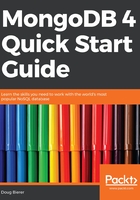
上QQ阅读APP看书,第一时间看更新
Documents, collections, and database
In order fully to understand how to use MongoDB, it is important to discuss the terms used to describe MongoDB data structures: documents, fields, and collections. The following table summarizes these three terms by way of illustration. In this table, we also draw an equivalence between MongoDB and RDBMS (Relational Database Management Systems):

In the preceding example, we see a document that represents information about a member whose name is Smith. Within the document are fields, the example highlighted being cost. Documents that are stored together for a single logical purpose represent a collection. A MongoDB database consists of one or more collections.
The astute reader will no doubt notice the lack of the MongoDB equivalent to a traditional RDBMS primary key. In the RDBMS, it is mandatory for the database developer to define one or more columns as the primary key in order to identify a given row uniquely. This is not required in MongoDB, as a unique identifying field _id is automatically added when the document is inserted into a collection. This field comprises an ObjectId ( https://docs.mongodb.com/manual/reference/glossary/#term-objectid) instance and uses a combination of factors to guarantee uniqueness.